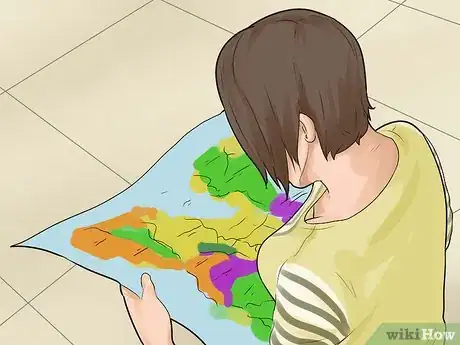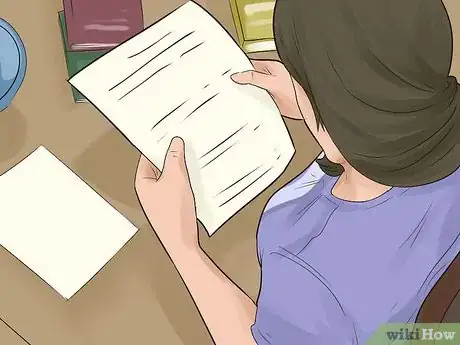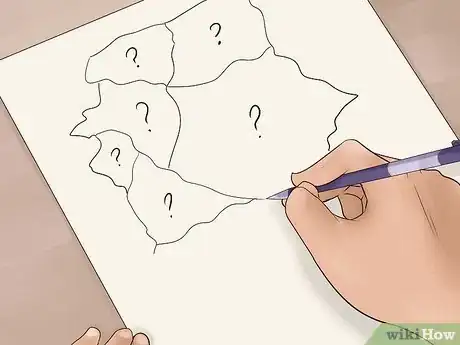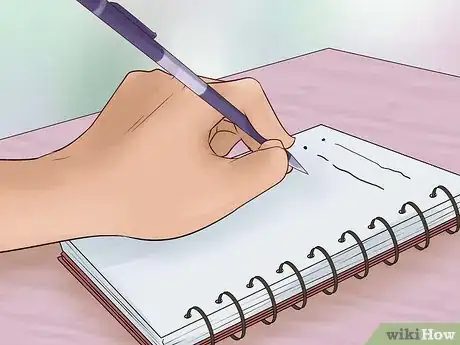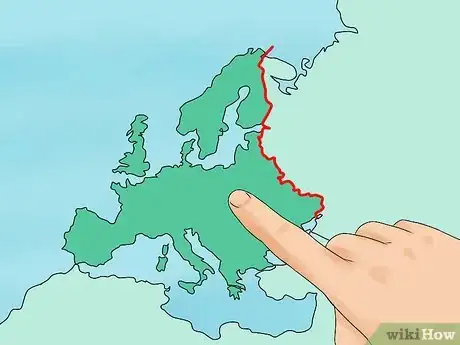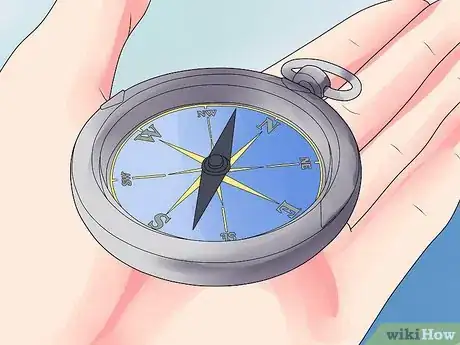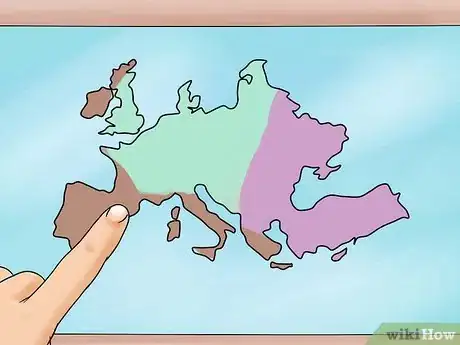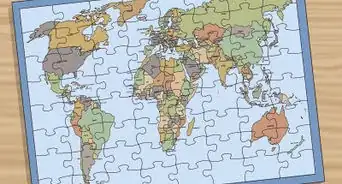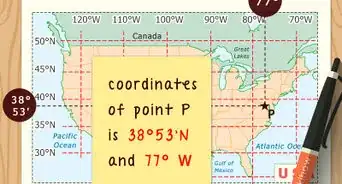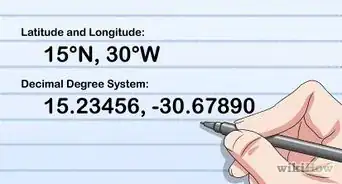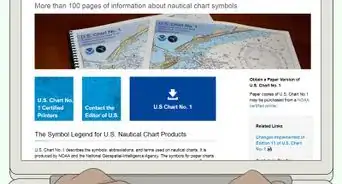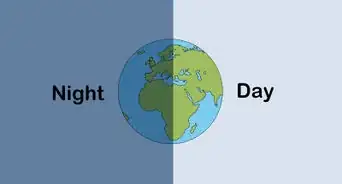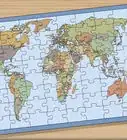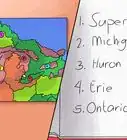This article was co-authored by Emily Listmann, MA. Emily Listmann is a private tutor in San Carlos, California. She has worked as a Social Studies Teacher, Curriculum Coordinator, and an SAT Prep Teacher. She received her MA in Education from the Stanford Graduate School of Education in 2014.
There are 10 references cited in this article, which can be found at the bottom of the page.
This article has been viewed 33,660 times.
Do you feel disappointed in your dismal knowledge of the world around you? Do you want to achieve success in the fascinating field of geography? Knowing how to read maps and place locations around the world will only expand your understanding of our planet. To become proficient in geography, you can do some home studying using world maps and the atlas, do geography exercises on your own, or enroll in geography classes to get instruction from a geography expert.
Steps
Studying the Basics of World Geography
-
1Look at world maps and atlases at your local library or your school library. Though the study of geography is about more than just maps, it can be helpful to have a visual reference. Head to your local library or your school library and look for world maps in color and as large as possible. You may also be able to find a world atlas, which will likely have smaller images of different regions or areas of the world.
-
2Study the 5 fundamental themes of geography. To become a geography master, you must first remember that geography is about more than just maps and cartography. In fact, to become proficient in geography, you will need to cover 5 fundamental themes:[3]
- Regions: You should know the different regions on the Earth as well as how these regions form and change over time.
- Location: You will need to be aware of where people and places are located on the Earth’s surface.
- Place: You will need to note the physical and human characteristics that distinguish one place from another as well as what makes a place special or unique.
- Relationships within places: You should be aware of how human interaction shapes the characteristics of the people and the environment.
- Movement: You will need to know how movement on the Earth, from people to products to information, affects the characteristics of places.
Advertisement -
3Identify the regions, continents, and major oceans of the world. Start by looking at the names given to places in the world, such as the regions of the world (Africa, the Americas, Europe, and Oceania), the 7 continents (Africa, Antarctica, Asia, Australia, Europe, North America, and South America), and the 4 named oceans (Atlantic, Pacific, Indian, and Arctic). You should think about how these regions were formed and how they changed over time.
- You may want to look at 3-D reenactments of Pangea, where geologists have shown how the world was broken into different regions over time through continental drift.[4]
- You should also consider how the regions of the world are broken into continents. You may want to look at the official list of cities in each region of the world to get a better sense of each region.[5]
-
4Learn the location of places with longitude and latitude. One of the most basic elements of geography is locations on the Earth. Every place on the map has a “global address," which tells you exactly where it is located. Note the 2 numbers in the global address; 1 number is for latitude and 1 number is for longitude. You can use latitude and longitude to find any place in the world and note its absolute location.[6]
- The equator divides the Northern Hemisphere from the Southern Hemisphere and has a latitude of 0°. The prime meridian has a longitude of 0° and runs through Greenwich, England.
- Latitude and longitude is mapped out using the grid system, with latitude indicating a place’s location on a horizontal axis and longitude noting a place’s location on a vertical axis. There are also directions assigned to each number based on their location in the world, such as north, south, east, or west. Being aware of how to identify a place’s global address will allow you to get a better sense of where it is exactly in the world and find it easily on a map.
- For example, you may note that your hometown of San Juan in Puerto Rico is at a latitude of 18° 27' N and a longitude of 66° 6' W. You may also note that your new home in New York City, NY is at 40° 42' N / 74° 0' W. You can then use this information to determine how much distance you and your family traveled on a map from your old home to your new home.
-
5Describe the differences between areas in the world. Geography explores what distinguishes one area from another area. You should consider what makes one location unique or different from another location. This could be its proximity to another larger city or area as well as its proximity to the sun. The location may also have environmental attributes that make it unique, such as a distinct landscape or a certain climate.
- You may want to use 2 areas as an example and work through the differences between the 2 areas. You can use your hometown and a neighboring town or a town that is on the opposite side of the globe. Consider the climate and the landscape of each location. You should also think about the language spoken by the people who live in each location and how they interact with their environment.
- For example, maybe you contrast your hometown of San Juan to your new home in New York City. The climate of San Juan is tropical, so it is usually humid and wet, with little to no dry season. In contrast, New York City is a subtropical climate but it is prone to freezing and snow in the winter months. San Juan is within a tropical rainforest, with a landscape of wetlands, but it is also located on the north coast and considered the country’s most important sea port. New York City is a port city as well but it is densely populated and urban, with only a few major green spaces.
-
6Consider how people in an area affect the geography of the area. Another aspect of geography is looking at how humans influence their environment and how the environment influences the activities of people. You should also consider how the environment was changed to accommodate the movement of people, products and/or information. These kinds of changes are important for understanding how the geography of a location shifted and why it has shifted.
- The Panama Canal, for example, was built across a narrow strip of land in Central America. It was built as a shipping lane between the Atlantic and Pacific Oceans. This was done because it made it easier to move goods back and forth between South America and other areas of the world. The Canal also shifted the environment of that area and affected the geography of that region.
-
7Compare several different maps of the world. To get a better perspective on how geography is determined, you should look at several different maps of the world and compare them. This will help you better understand why locations are placed in a certain area on maps and how other elements like politics, class, wealth, and race have all affected how maps display the world.[7]
- A map made by a European cartographer, for example, may always feature Europe prominently and place other regions as secondary. Many of the maps used in schools show the Eurocentric map, but scholars have started to flip around these maps to show how we can view the world map in different ways. An upside down Eurocentric map will show the East as the top of the map, with China, Indonesia, and Australia in the center of the map.[8]
- You may also want to look at maps that showcase or highlight different areas of the world based on certain guidelines or distinctions. For example, a map may show where people live based on their economic status, or the major shipping routes during the colonial era.[9]
- Note that an atlas is a collection of maps. You may want to compare an old atlas and a new atlas to see how the maps have changed over time.
-
8Check out travel blogs and websites. If you are interested in a particular geographic area, you can look at travel blogs and websites about that place. You can learn a lot about smaller cities or towns within a region from such sources, as well as about topographical features like mountains or rivers.
- You’ll also get to see photos of the area and learn about what makes it uniques, such as the types of food native to the area or commonly celebrated holidays that may be different from your own.
Doing Geography Exercises
-
1Sketch your immediate geography at school or at home. To get a more intimate sense of geography, you can practice drawing free-hand sketch maps of your house, your neighborhood, your school, and your town. You may also try to map out your state and your country. Compare your maps to the maps in atlases and note the gaps in your knowledge. Consider how you might be able to find more information on certain areas that you were not able to draw on your own.
- You may also walk around your home or school and use your eyes to help you map out the space. This can also be a good excuse to take a walk around your neighborhood and make a map of the area through moving through the area. You may notice details you do not usually pay attention to and get a better sense of the geography of your neighborhood.
-
2Use cardinal directions to locate objects in your home. One fun way to get better at identifying the cardinal directions (north, south, east, and west) is to have a friend or parent hide objects in your room and then locate them using directions. For example, the friend may say, “two steps to the east and four steps to the north." You can then try to use your own sense of direction and/or a compass to help you locate objects using cardinal directions.
- You can also extend this game to identifying locations on a map based on cardinal direction. For example, maybe you note that your hometown of San Juan is on the north coast of Puerto Rico and east of the equator.
-
3Watch current news and locate the events on a map. Connect the news of the day to geography by noting where events occur on a map. You may watch world news and try to place the events where they occurred based on city or region. You may also watch local news and place events on your map of your home state or your neighborhood. Doing this can help you notice any patterns of where certain events are taking place in the world and come up with theories on why this may be.
- You may also get a better sense of how events can be tied to geography. For example, an earthquake may occur in a region that is located on a fault line. Or a hurricane may go through a tropical area due to its location in the ocean.
-
4Play world mapping games online. You can brush up on your geography knowledge by playing mapping games online. Use games that allow you to follow a certain character around the world on a search for clues or to solve a mission. You can also play games that require you to correctly identify the names of places in the world and certain details about the environment of these places.
- One popular mapping game is Where in the World is Carmen Sandiego?[10]
- You can find a list of mapping games for kids through the BBC at: http://www.bbc.co.uk/schools/websites/4_11/site/geography.shtml.
-
5Take a geography test. If you feel like your geography skills are close to masterly level, you may want to try taking a geography test. This can be a test that your parent or guardian comes up with for you or a test that you take online. You may also be able to customize quizzes online to focus on a specific area or region you are trying to study up on.
- A list of geography tests and quizzes can be found online.[11]
Enrolling in Geography Classes
-
1Sign up for a geography class at school. This may be a good option if you are in secondary school and would like to expand your knowledge of geography. Sign up for a world geography class at your middle school or high school. Some secondary schools have units in Social Studies that focuses on world maps. You may want to study more in depth during those units so you are more aware of the subject.[12]
- If you are home schooled, you can access online tools to help you achieve a more well rounded study of geography. Work with your parents or guardians to integrate geography into your home school studies.
-
2Enroll in an online geography class. There are many geography classes offered online for older students who have graduated high school and are looking for continuing education courses in geography. Many online geography classes can be taken module by module and at your own pace, under the guidance of an instructor or tutor.
-
3Consider majoring in geography at the university level. If you are interested in becoming a certified master of geography, you may want to enroll in a geography degree at the university level. Majoring in geography at the undergraduate level can allow you to delve deeper into the study of geography and open career doors, as there is a consistent need for geographers in the field.
Community Q&A
-
QuestionCan I learn all the regions of the world within a month?
 Community AnswerIf you put your mind to it and study often, then yes!
Community AnswerIf you put your mind to it and study often, then yes!
References
- ↑ http://www.internetgeography.net/
- ↑ http://www.worldatlas.com/
- ↑ http://www.ericdigests.org/1992-5/geography.htm
- ↑ http://geology.com/pangea.htm
- ↑ http://geography.about.com/od/lists/a/officiallist.htm
- ↑ http://www.ericdigests.org/1992-5/geography.htm
- ↑ https://www.flourish.org/upsidedownmap/
- ↑ http://america.aljazeera.com/opinions/2014/2/maps-cartographycolonialismnortheurocentricglobe.html
- ↑ https://www.washingtonpost.com/news/worldviews/wp/2014/01/13/40-more-maps-that-explain-the-world/
